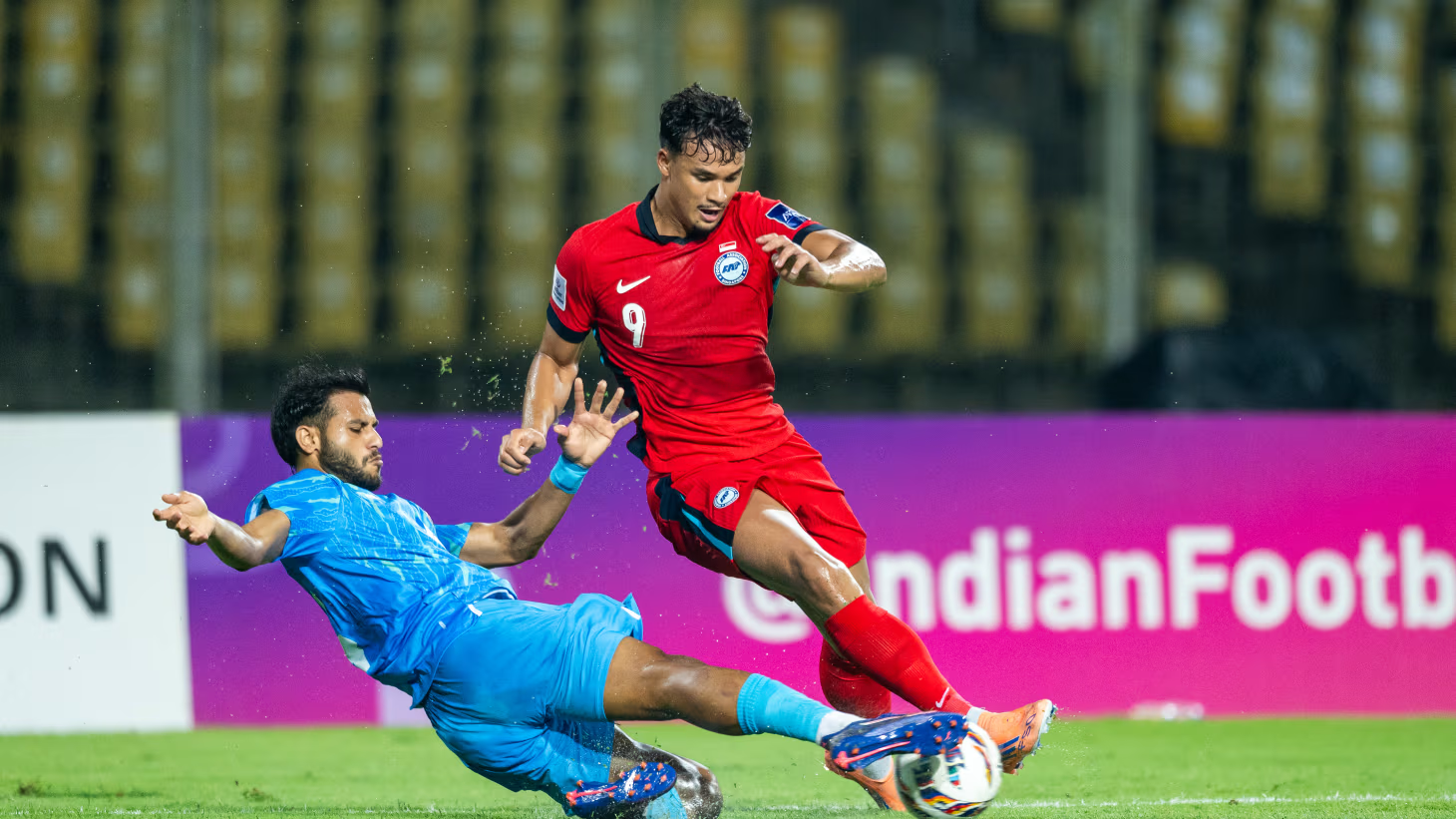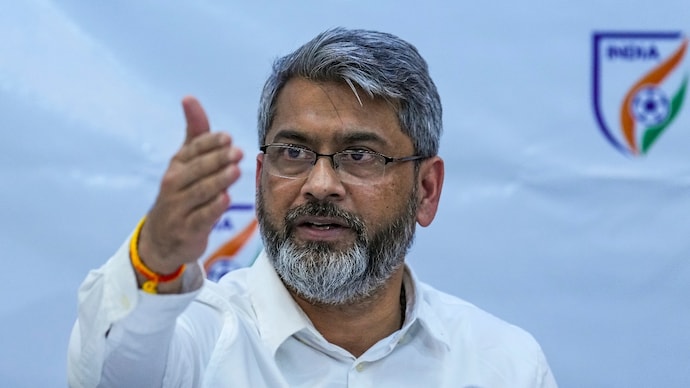The FIFA World Rankings update of October 17, 2025, delivered a sobering reality check for Indian football. The Blue Tigers have slumped to rank 136, their lowest position in nearly a decade, and their poorest standing since November 2016 (rank 137).
This latest slide down two places from 134 is not a mere statistical dip. It represents the culmination of two years of competitive stagnation, structural dysfunction, and leadership instability that has left Indian football’s senior men’s team at a crossroads. With just 1096.65 ranking points, India now sits below Kuwait (135) and only marginally above Botswana (137) a stark contrast to the optimism that followed their peak of rank 99 in 2023.
From Hope to Collapse: The Competitive Chain Reaction
India’s decline was triggered by failures in two major qualification campaigns for the 2026 FIFA World Cup and the 2027 AFC Asian Cup. The breaking point came in October 2025, when the team was eliminated from Asian Cup qualifying following a 1–2 home defeat to Singapore (ranked 155), after managing just a 1–1 draw in the away leg.

That loss didn’t just end India’s immediate qualification hopes it shattered their FIFA points total through the Elo-based ranking model, which penalizes defeats to lower-ranked sides in high-stakes matches. With both games classified as high-importance fixtures (I=25), the impact was magnified, eroding nearly 9.3 ranking points in a single international window. The defeat to Singapore epitomized everything wrong with Indian football’s current structure poor tactical planning, lack of attacking cohesion, and psychological fragility in decisive fixtures. More importantly, it exposed the team’s inability to perform when stakes and expectations align.
The Elo Mechanics: How the Numbers Punish Failure
FIFA’s ranking system uses the Elo formula, where each result affects the team’s total points based on match importance, opponent strength, and outcome. In India’s case, the AFC Qualifiers carried the highest coefficient in Asia (I=25, with a 1.10 multiplier). Losing such matches especially against lower-ranked opposition compounds ranking loss. The home defeat to Singapore (WR 155) was classified as an “upset,” causing one of the steepest points deductions possible within the regional context.
| Match Type | Importance Coefficient | Impact |
| AFC Qualifier | 25 | Heavy penalty for losses |
| Continental Finals | 25 | Compounded from AFC Asian Cup losses |
| Intra-continental Factor (Asia) | 0.8 | Dampens recovery, limits points gain |
This mathematical punishment mirrors the sporting one: India’s inability to secure results in high-I matches not only lowers morale but also traps them in a ranking regression spiral that will take years to reverse.
Since a 1–0 win over Kuwait in November 2023, the Blue Tigers have failed to register a single meaningful victory.
The 2024 AFC Asian Cup campaign was disastrous: three matches, three defeats, zero goals scored. The subsequent qualifiers including losses to Hong Kong (0–1) and Singapore only extended the drought. Meanwhile, India’s regional peers have quietly progressed. Singapore rose three places to 155, Bangladesh climbed to 183, and Pakistan to 198. For the first time since 2015, India’s relative strength within South and Southeast Asia has declined, reflecting not just stagnation but regression.
Leadership Crisis: The Carousel of Coaches
If there’s one constant in Indian football’s chaos, it’s inconsistency in leadership. Since 2023, the national team has cycled through three head coaches Igor Štimac, Manolo Márquez, and now Khalid Jamil each with a different philosophy and none given the time or stability to implement it. Štimac’s tenure ended amid disputes with the All India Football Federation (AIFF) and inconsistent tactical results. His successor Márquez, hired for his ISL pedigree, managed just one win in eight matches before being dismissed.
The appointment of Khalid Jamil in August 2025 the first Indian coach in 13 years was supposed to reset the narrative. His early results at the CAFA Nations Cup hinted at progress, but the Singapore defeat placed him under immediate pressure. However, the problem extends far beyond the coach’s dugout. The AIFF’s reactive approach firing coaches at the first sign of trouble has prevented the formation of a coherent tactical identity. Each transition resets the system, diluting accountability and disrupting player development.
The Governance Black Hole: AIFF’s Institutional Paralysis
The AIFF’s ongoing administrative turbulence has only deepened the crisis. Since 2022, the federation has operated under judicial scrutiny following Supreme Court interventions mandating structural reform and commercial transparency. In 2025, the focus shifted to the ISL commercial rights RFP, a 15-year contract worth hundreds of crores. However, delays in finalizing this deal and missed court-imposed deadlines diverted crucial managerial attention from national team operations. The proposed reforms, including promotion and relegation for 2025–26 and a salary cap of ₹18 crore per club, remain in bureaucratic limbo.
While AIFF President Kalyan Chaubey insists that domestic football infrastructure has improved, these advances have not translated to national success. In fact, the obsession with commercial restructuring has come at the expense of high-performance focus the fundamental bridge between club development and international results.
The Domino Effect: Seeding and the Future Trap
India’s fall to 136th has far-reaching consequences. The new ranking ensures that for the 2026 FIFA World Cup Asian qualifiers, India will be placed in the lowest seeding pots, facing tougher groups and fewer winnable fixtures. Worse still, under the AFC Nations League (2027–31) framework, teams ranked outside Asia’s top 32 risk being relegated to League C the third tier. This would confine India to low-ranked opponents and low-importance matches (I<15), dramatically slowing their potential ranking recovery.
It’s a vicious cycle: low rank leads to poor seeding, which leads to fewer competitive opportunities, ensuring the team remains stuck in the bottom rungs of global football.
How India Can Rebuild: The Roadmap to Recovery
To reverse this freefall, Indian football requires not cosmetic adjustments but systemic overhaul.
- Governance Reform: The AIFF must finalize the ISL commercial structure, stabilize its internal administration, and redirect attention to national team performance metrics. Governance must be transparent, accountable, and performance-driven with measurable KPIs tied to FIFA ranking improvement and competitive win ratios.
- Coaching Continuity: Khalid Jamil must be given at least a four-year cycle with institutional backing. Constant resets have crippled tactical identity. India needs a consistent playing philosophy, blending domestic ISL talent with overseas-based players, supported by a modern analytics-driven backroom team.
- Ranking-Aware Match Planning: The AIFF must adopt ranking-sensitive scheduling. Friendly matches should target teams ranked between 100–120, maximizing potential point gains from wins or draws. Avoiding fixtures against teams below rank 150 where upsets cause severe penalties is equally vital.
- Quantitative Target Setting: To re-enter the Top 110 by the end of 2026, India must record at least six wins and two draws in 12 high-importance fixtures. These objectives must be publicly stated and evaluated quarterly.
India’s fall to FIFA Rank 136 is more than a ranking update it’s an indictment of systemic dysfunction. The Elo model simply quantified what the eye already saw: a national team adrift, burdened by administrative chaos and tactical confusion. Yet, within crisis lies opportunity. The path back to the Top 100 will not be quick, but it remains possible through governance clarity, coaching continuity, and competitive accountability.
The Blue Tigers have fallen far, but the question that will define Indian football’s next decade is not how deep they’ve gone it’s how determined they are to climb back.
FIFA Ranking (October 2025): 136
Next Fixture: India vs Hong Kong, AFC Nations League Qualifier, November 2025
How useful was this post?
Click on a star to rate it!
Average rating 5 / 5. Vote count: 3
No votes so far! Be the first to rate this post.






